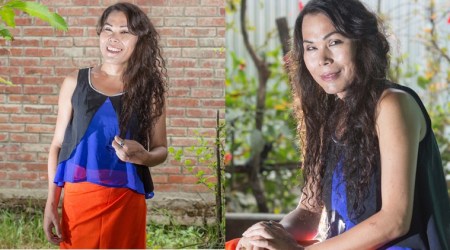 What lies ahead: Artist Gigi Scaria explores the urban world in ‘Fragmented Reality’
What lies ahead: Artist Gigi Scaria explores the urban world in ‘Fragmented Reality’
Sometime last year, artist Gigi Scaria felt the need to understand the process of architectural model-making that is intrinsic to urban development. Concepts related to city-building have always intrigued him —as is evident from his artistic trajectory— but he wanted to meet the anonymous labourers who give shape to the vision of architects. He found one such worker not far from his home in Greater Noida and through him discovered the complexities of his trade.
Back in his studio, Scaria designed models of the future he anticipates, one where plastic skyscrapers jut out from a hollow bronze tree bark and where apartments carry with them a sense of alienation. “Urban stories all over the world nearly come to a standstill when we look deep into their relation with environmental devastation and exploitation of natural resources. The painful truth of human existence has made its brutal assertion on everything perceived and imagined,” says Scaria, explaining the ideas that guided his solo ‘All About This Side’ that will open at Aicon Gallery in New York on August 10.
On view will be installations, videos, watercolours and photographs where Scaria, 44, will deliberate on how “the future we imagined has already become a burden to carry forward”. “A fence against unaccepted realities and unappreciated future is already under construction. The walls that divide people are becoming more permanent, as opposed to building a better habitat for the ‘survivors’,” says Scaria. The titular work, ‘All About This Side’, is an inkjet print that has a long iron fence outside a mall under construction in Noida, marking the territorial boundary between those it is meant to cater to and the “have-nots” who are encouraged to view it all from a distance. In the installation ‘Philosopher’s Stone’, he presents cement as the legendary alchemical substance, and another installation, ‘Trial’, places alienated individuals in the witness stand, under trial for the sins they have unknowingly committed against ecology.
The exhibition in the US comes a year after his acclaimed solo at the Laumeier Sculpture Park in St Louis, Missouri, where he explored the architecture of St Louis and New Delhi. He was in the US in 2013 too, when his immersive installation ‘City Unclaimed’ was exhibited at the Smart Museum of Art in Chicago for almost a year. The photo-based mural of an imaginary cityscape showed the extreme disparities that exist in the Indian capital, and the accompanying twelve-foot high fountain resembled Delhi’s apartment buildings, with constantly flowing water raising concerns over scarcity and allocation of resources.
 Build me a future: Plastic skyscrapers and lonely apartments.
Build me a future: Plastic skyscrapers and lonely apartments.
“The issues are universal, only the nature and degree might vary,” says Scaria.
Engagement with the environment, urbanisation and migration have dominated Scaria’s work for over two decades now, ever since he moved to Delhi from his hometown Kothanalloor, a village in Kerala’s Kottayam district, in 1995. He was still pursuing his post graduation in art at Jamia Millia Islamia when he started sketching abstract maps of Delhi. As the city changed, numerous layers were added to the maps, as Scaria made notations to document its illegal constructions, mushrooming shopping malls or even the Delhi Metro that is gradually expanding across the city.
“When I first came to Delhi I was fascinated by the different language groups and the social and class hierarchies that were so blatant,” says Scaria. Even as he tried to understand its inner workings, the city emerged as his muse. His first solo in 1998 at a gallery near Jamia Millia in Delhi comprised his abstract maps and ceramic sculptures, but it was the much-acclaimed ‘Absence of an Architect’ at Palette Gallery in Delhi in 2007 that affirmed his position as an artist of reckoning.
Born to parents who owned shops in Kothanalloor, Scaria was six when his grandmother guided him to mould the crucified Christ with clay from paddy fields. He would spend hours reproducing Renaissance paintings and sculptures published in the Malayalam magazine Bhashaposhini. A curious child, he pondered over books in the local library, dreaming of fulfilling his own artistic pursuit. The quest for learning led him to experiment with multiple mediums: installations, screen prints, photography, painting and sculpture. It was after attending a residency at the Michelangelo Pistoletto Foundation in Italy through an Inlaks Scholarship in 2002, that he began to experiment with video art, a medium that was still nascent in India. “I was interested in filmmaking and this was an extension,” says Scaria. The subjects depicted contemporary concerns. For one of his early videos, ‘A day with Sohail and Mariyan’, in 2004, he followed two ragpickers for a month. In another video, ‘Raise your hands those who have touched him’, he interviewed people who had interacted with Mahatma Gandhi.
With layered works that address the past, present and the distant future, Scaria has consistently reflected on the complexities that we live with. Describing “one of the primary themes of Scaria’s art”, curator Ranjit Hoskote has written on how it addresses “the crisis that has been forced upon the planet as a result of the reckless onslaught that humankind has visited on its surroundings at a constantly accelerating pace since the dawn of the Industrial Revolution”. When Hoskote was invited to curate India’s first national pavilion at the Venice Biennale in 2011, he chose Scaria to be part of the group that comprised four artists. At the prestigious art event, people reportedly queued up to enter Scaria’s video installation ‘Elevator From the Subcontinent. It transported viewers to India, taking them to urban homes belonging to people from different stratas of society.
At the second edition of the Kochi-Muziris Biennale in 2014-15, Scaria explored his home turf. Taking off from curator Jitish Kallat’s vision to turn Kochi into a pier from where artists would view the world, Scaria designed a 13-foot tall steel bell, moulded and welded in Coimbatore. Installed at the backyard of Pepper House, an 18th-century Dutch-style complex, by the Mappila Khalasis — traditional dockyard workers from the ancient port town of Beypore, located 180 km from Kochi — the work titled ‘Chronicle of the Shores Foretold’ also referred to the ancient folklore of the region where a European ship bringing a large bell for a church sunk due to the weight of the bell. “It is a tale children in Kerala are often told. We even celebrate the rising of these bells from the deep waters during an annual church festival,” says Scaria. He admits being more familiar with the land he grew up in than any other and has a connect with immigrants, whose sentiments he often depicts. After over two decades of living in Delhi, he still feels he doesn’t belong here. “I am very comfortable but I am still an outsider in some sense. That is the reality of today. None of us really belong to a particular place,” he says. His works, meanwhile, are being installed for the transoceanic audience— who, over the years, he has familiarised with the Delhi skyline.







